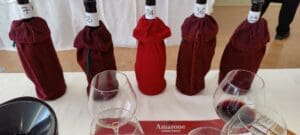This year’s Valentine’s Day was a moody one for the wine makers in France. A research study published by renown France Laboratoire Excell reported chemical residues were found within 90% of finished wines. While there hasn’t been any complaint made against toxicity effect arises from wine consumption (other than alcohol poisoning), it is certainly worthwhile to investigate their potential harm.
In late 2007, the France government set out with the Ecophyto 2018 project. Focused on protecting the environment from agricultural damage, targets to cut chemical usage by 50% and eventual elimination of 53 chemical preparations containing active substances from the market were laid down, somewhat overly idealistic. The report, published 5 years later, demonstrated greater irony. Today’s chemical usage had increased 2.7%.

For the consumers it is perhaps more noteworthy that the wines investigated were from Bordeaux, Aquitaine (south-eastern France) and Rhone. Geographically making up a quarter of France terrain, these regions produce wines representing the bulk of market. Don’t get panicky and start using these precious wines for toilet cleaning, though one should consider the price movement if there is an upcoming confirmation of toxicity.
In some of these regions where high humidity exists, fungal diseases are one of the common problems. Botrytis Cinera, the fungus responsible for noble rot sweet wine and the white cotton-like Powdery Mildew are among those which grape growers seek to inhibit. White fluffy mealybug is another major concern. Thrive in moist warm climate and feed on plant sap, mealybugs can harm the plant vigour, and eventually balding canopy.
The prevailing chemicals found are mainly for ‘anti-fungi’.
Just how bad can it be? No one has concrete evidence whether fermentation can make residual chemical harmless or harmful. But operational damages are certain. Farm workers are the primary victims of chemical exposure. Further ecological damage through water run-off, wind dispersion and killing of beneficial organisms are often not fully understood in a short-term study.
Agriculture chemicals have been one of the most important aids for farmers. Without which, economical needs cannot be met and nothing can be produced. But in the pursuit for greater gains it is not uncommon to see excessive use of chemicals and antibiotics in farming. Chemical decomposition takes a longer period compared to organic decomposition. In Burgundy, some underground water reservoirs are contaminated with herbicide since early 2000s and unsafe for consumption.
Chemical free agricultural
In the report by Laboratoire Excell, researcher Pascal Chatonnet pushed for greater focus on organic farming. In recent years there are more vines grower heading towards organic and biodynamic but the primary obstacle to these practices are usually financial driven. Low yielding harvest, increase labour intensity and higher operational cost. Noting the difficulties for some regions and their high degree of susceptibility to diseases, the next best solution is to go into an elaborate selection of suitable chemical, reduce dosage and frequency of application.
Handling diseases and eliminating pests are two different matter. Pests are generally considered as organisms that are offensive to human. This applies to both plants and animals, therefore vineyard weeds are as much of a pest as fruit-eating birds in Napa. One of these approach is Integrated Pest Management or IPM. Since most pests have natural predators, farmers can introduce these predators to the ecosystem.
Using the aforementioned mealybug case, farmers introduce ladybirds or mealybug destroyers into the field. These crop-friendly carnivorous bugs enjoy hunting down adult mealybugs and its offspring. But the nature of this approach is extremely targeted and not one size fits all.
Example of household IPM, keeping rabbits to keeps weeds off carpetgrass.
Vine diseases usually need chemical-based contact treatment. Sulphur is one such permitted chemical within organic farming framework. A natural element that exists on this planet before Earth turned oxygen-rich, sulphur and its (safe) derivative compounds are usually used to kill most fungi and they will react with air or be broken down.
As a consumer, I have never been particular on how my food got on to the table. But after the study I do believed there’s a need for radical change in our beliefs. Organic farming is initiated by producers but can be supported by consumers. And that’s us.



